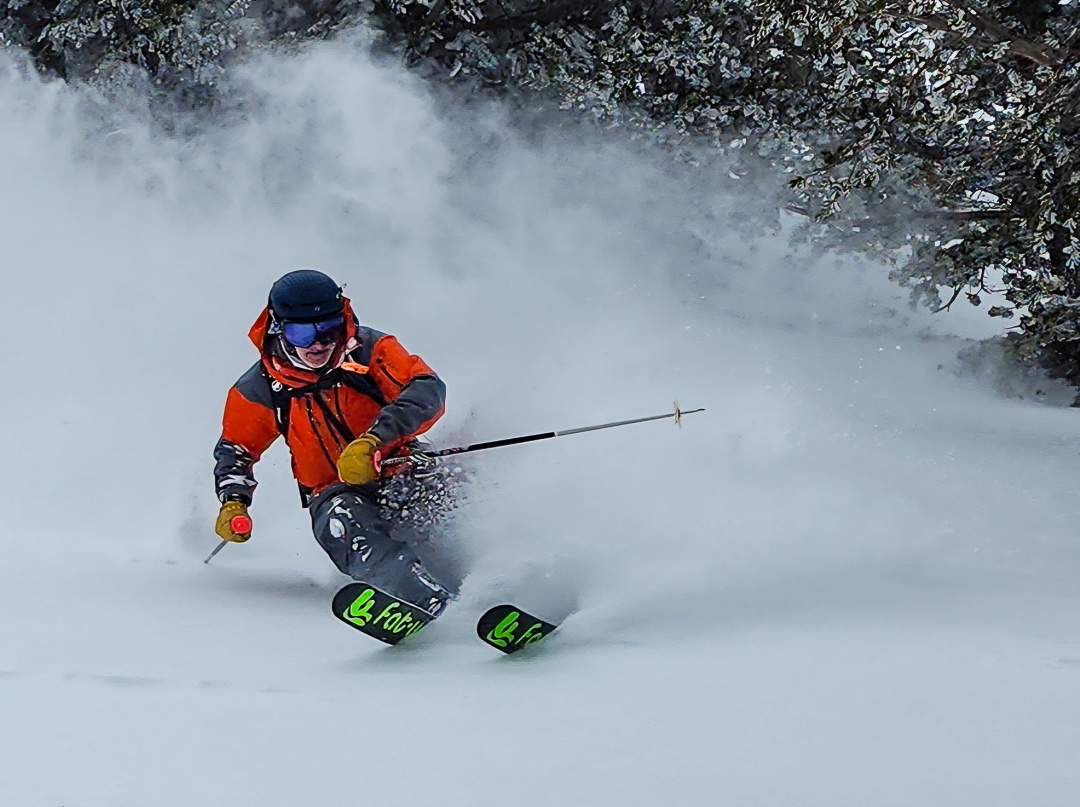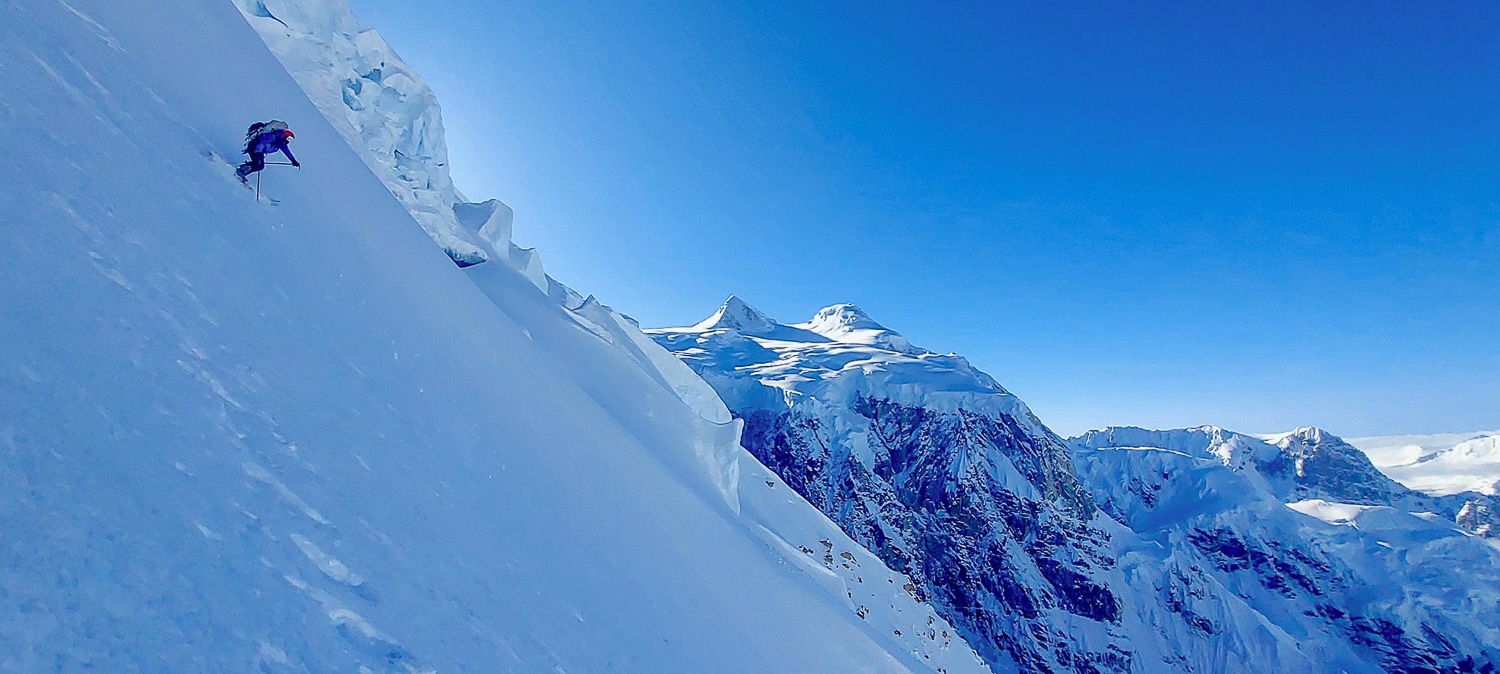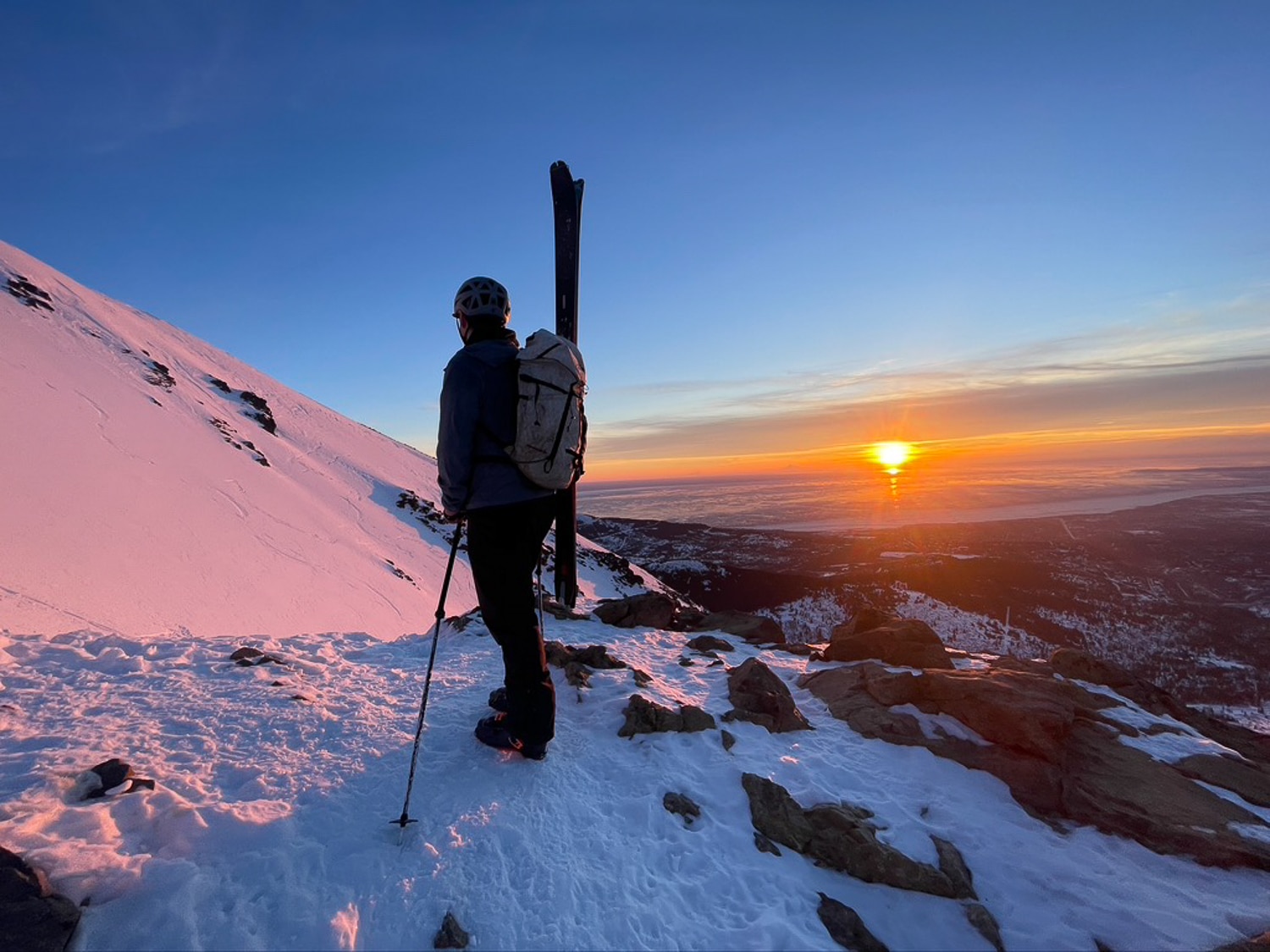There are good reasons for sticking with touring ski tradition. Touring skis are traditionally lightweight and have at least a medium to long turn radius. Typically, they’re pretty stiff in the tails and sometimes in the tips, with a good bit of camber running some length of the ski. These qualities can make a ski perform well climbing, kick turning, holding an edge, ascending tricky slick side-hills, and descending harder snow in steeper terrain. They are predictable in the mixed conditions often encountered in the backcountry. There is a huge selection of skis that match this general description. They are generally excellent. And I don’t really like them.
You may find other options that suit your style a bit better. Accordingly, a ski that has become a favorite of mine does not conform to tradition.
They are the Fat-ypus D’Vice. Fat-ypus is a brand out of Vermont with its roots and manufacturing in Colorado. I got them second-hand from Fat-ypus, so they came well-loved but still in great shape. The D’vice, at 110mm under foot, are soft in tips and tails, smoothly transitioning to stiff under foot, with a low camber. They are a 5-point shape, which moves the ski’s widest part closer to the middle. This design creates a tight turn radius while also creating a narrower tip and tail that helps initiate and release from turns quickly. Those soft tips also rise early. The result of the dimensions and layup is a highly maneuverable, damp, and playful ski.
The Skiing
Most of my time on the D’vice has been on varieties of soft snow where they’re lightning quick to turn. Lightning turns, pillowy float, confident and playful. So fun. On harder snow where you edge, they rail tight carves, and oh, what a joy that is! They’re an absolute blast.
Based on the traditional touring ski values espoused in online chat and après ski bar rooms, a ski of this sort should not be a good choice for many reasons—their shape can be “hooky,” especially in weird snow, they’re too soft and have too little edge on snow to hold an edge on hard pack. They aren’t stiff, straight, and Euro enough to be cool. So far, I can confirm that while straight and somewhat stiff, I am not very cool. The skis, however, are, in fact, a blast on carvable harder snow such as softer windbuff and corn. The tight turn radius gives me delusions of Shiffrin. Leave me alone; I know I don’t ski like she does. But damn if, at times, I don’t feel like I am. The steeper it gets and the more I throw the skis sideways rather than carving, the more I want a narrower, more spring-oriented ski—such as the Line Vision ’96 (review pending). And frankly, the more I’d wish for softer snow rather than a different ski. As for weird and hooky snow—I felt as confident on the D’vice as any other ski. Unlike the Atomic Backland (more of a comparison below), I never felt locked into a turn or struggled in weird snow. Breakable crust is always challenging, but I didn’t feel the D’vice’s were more challenging than a more traditionally shaped or built ski.


The D’vice is 110mm underfoot and so really not oriented toward hard snow skiing—but in touring, versatility is a very important quality, a necessity even, and so it’s a point that we must evaluate. And so, while the D’vice isn’t made for skidding turns in steep-hard snow, I’ve felt secure enough doing so. This spring allowed me to take them out in rough conditions, returning from some creamed corn. They were dreamy in the corn, performing much like they do in powder, and were super damp and smooth in the beat-up snow lower down—which isn’t surprising as they are an in-bounds ski.

Climbing
The D’vices are 1820g (4lbs) a piece. They don’t present a lot of skin on snow because of their early rise tip, and the pronounced 5-point design makes them less secure on steep kick-turns in slick snow than a straighter, more traditionally cambered ski. I shouldn’t overstate these attributes, but they are noticeable. They’re less nice to skin on than more traditional skis but are easier than reverse cambered planks. And when it comes to weight, what can be said? I wish they were lighter heading up, but I’m happy they’re not coming back down. This is a trade-off; climbing is my only complaint about these skis.
Some Comparisons
Trade-offs aside, the D’vice has become my new favorite. But how do they compare to a few other skis I’ve been on lately?
The D’vice is similar to the DPS RP100 in shape and flex but is more extreme on paper and snow. Tighter, softer, wider, and fun. Where the RP100 is versatile, quick, and confidence inspiring, the D’Vice is that plus some. The D’vice is a heavier and wider ski. The lighter and narrower RP100 is a bit less stable and gets banged around in rough snow more easily. Trade-offs. Love both skis. A head-to-head with the DPS 112 may be warranted.
Compared to the Line Vision 108, the D’vice is quicker to turn but similar in many respects. Again, the heavier D’vice provides some nice support in rough conditions. The tighter turn radius of the D’vice makes carving even more fun than the Vision 108. The Vision 108 climbs much better in all respects. Repeat the mantra—love both skis.
An interesting comparison is to the 4FRNT Raven. Both skis break with tradition but in very different ways. The Raven is super stiff and fully reversed cambered. Though it has a long turn radius, it is also really quick and easy to pivot. Both are not the best on a slick skin track, but the D’vice climbs a bit better on a hard, slick up-track but is a bit less secure on awkward side-hill traversing. I prefer the next ski in both cases.
Most recently, I have been skiing the 2025 Line Vision 96. The D’vice, compared to all these skis, is far more damp and, despite its width, is very quick to pivot and carve. That is even compared to the Vision, which has a similarly low camber but a longer turn radius. The Vision, on the other hand, is way better to climb on and holds an edge much better in steeper and harder snow ascending and descending.
Fat-ypus D’vice vs Atomic Backland 107. The Backland 107 actually has some similarities in shape to the D’vice. The Backland does have a wider point moved away from the tip and tail. It has some early rise in the tip as well. But it is stiffer in both tip and tail and has a stiffer and longer cambered mid-section. The Backland 107 is a well-loved touring ski, and I can see the appeal. It’s a more traditional ski with a nod toward more modern thinking. And it is quite lightweight. Yet, I do not love the Atomic Backland 107.
I’ve had skis similar to the Backland 107 before, most notably the Praxis BC, a beautiful ski with a fairly traditional build. They have epic edge hold, skin great, and are stable at speed. With speed, the Praxis BC can turn like a firecracker. It’s incredible. They are packed full of energy, springing from turn to turn. But under my feet, they’re a one-trick pony, and that trick takes either a lot of effort or speed to pull off. The Backland 107 is similar in that I need more space and speed to appreciate its qualities. According to legend, they should have been easier in difficult snow, while I found them predictable; they were much more laborious in heavy or harsh snow than skis like the DPS 100RP, the D’vice, or the Vision 108.
There are reasons for sticking with tradition. And there are reasons for breaking with it. The D’vice is a blast to ski and offers a great glimpse into a different approach to building skis. Next winter, when the soft snow flies, I will be eager to see if anything can match it.
Basic Stats
Price: $895.oo on the Fat-ypus site, the 182s can be found on sale on the site.
Test Length: 175cm
Tail Height: 67mm
Camber: 5mm (seems lower)
Tip Height: 71mm
175cm beta: radius 12.5m, actual weight 1820g
182cm beta: radius 14m, claimed weight 1820g (actual not measured)
Layup etc: rockwell 48 steel edges, p-tex sidewall, vertical laminate poplar wood core, durasurf sintered base, die-cut graphics






Leave a Reply
You must be logged in to post a comment.